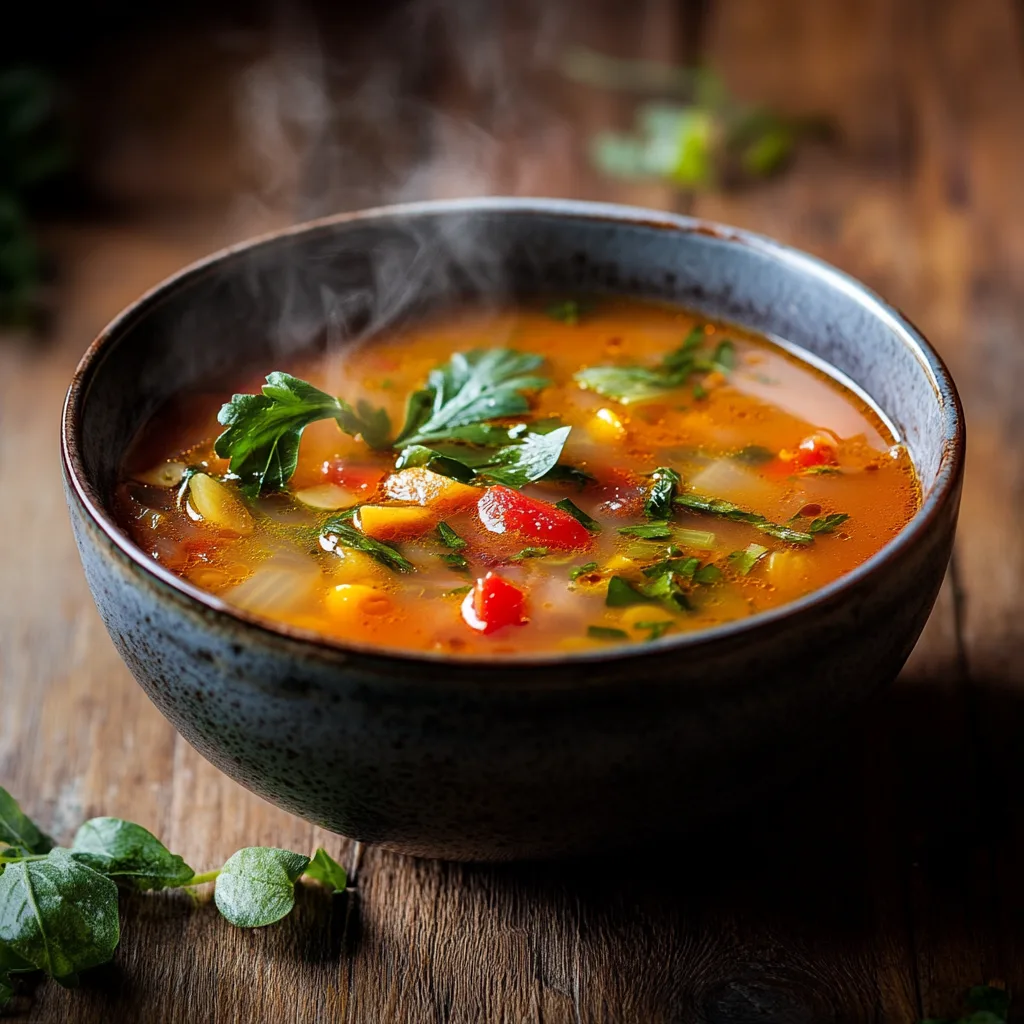Introduction
Soup is more than just a warm bowl of comfort on a chilly day—it’s a culinary masterpiece crafted with thoughtful layers. The secret to making a flavorful, well-balanced soup lies in its four essential components. These building blocks—the liquid base, thickeners, main ingredients, and garnishes—each play a crucial role in creating a harmonious dish. In this article, we’ll break down these components, explore their significance, and provide tips to elevate your soup-making skills. Let’s dive into the first part: understanding the four core components of soup.
Understanding the Four Components of Soup
What Is a Liquid Base in Soup?
The liquid base is the soul of any soup—it’s where everything begins. This component typically involves stock, broth, or even water, depending on the soup’s style. Stock, made by simmering bones, vegetables, and aromatics, delivers a robust flavor that forms the backbone of hearty soups. Broth, a lighter option, works well for delicate soups like consommés. For simplicity, water can be used too, but it’s essential to season it generously to avoid bland results.
When selecting a liquid base, consider the type of soup you’re making. A chicken stock adds richness to creamy soups, while vegetable broth enhances the freshness of a light minestrone. Add spices, herbs, and seasonings early in the cooking process to infuse layers of flavor. Remember, a great soup begins with a well-seasoned liquid base.
How Thickeners Shape the Texture of Soup
Ever wondered how soups achieve that luscious, velvety texture? It’s all thanks to thickeners. These agents, which can include roux (a mixture of butter and flour), cream, pureed vegetables, or even cornstarch, enhance the consistency of your soup. For example, a creamy potato soup relies on pureed potatoes as a natural thickener, while bisques often use a touch of cream to achieve their signature silkiness.
When adding thickeners, timing is key. A roux should be cooked with the base to ensure it blends seamlessly. For starch-based thickeners, whisk them into the soup toward the end to avoid clumping. Play around with ingredients like coconut milk or cashew cream for dairy-free options that still deliver rich, thick textures.
Why Main Ingredients Are Essential for Soup
The main ingredients are what make your soup stand out. These typically include a combination of proteins, vegetables, and grains or pasta. Proteins like chicken, beef, or lentils add substance, while vegetables provide a burst of nutrition and flavor. Don’t forget the grains—rice, quinoa, or noodles lend heartiness and balance.
To achieve the perfect harmony, think about how these elements complement each other. For instance, pairing a starchy ingredient like potatoes with a lean protein creates a satisfying dish. Cut your vegetables uniformly to ensure even cooking, and add delicate ingredients, such as seafood or leafy greens, toward the end to avoid overcooking.
Garnishes: The Final Component of Soup
Finally, the garnishes. These finishing touches might seem small, but they pack a punch when it comes to flavor and presentation. Fresh herbs, such as cilantro or parsley, brighten up any soup, while a drizzle of olive oil or dollop of sour cream adds richness. Don’t forget about textures—crunchy croutons, crispy bacon bits, or toasted seeds can elevate the simplest soup to something extraordinary.
The beauty of garnishes lies in their versatility. Mix and match flavors and textures to suit the soup type. A swirl of yogurt complements spicy soups, while a sprinkle of parmesan cheese works wonders on tomato-based broths.
Why Each Component Is Crucial in Soup-Making
How the Liquid Base Impacts Soup Flavor
The liquid base is the backbone of any soup. It acts as the medium that carries and blends the flavors of the other components. A well-made stock or broth adds depth, transforming even the simplest ingredients into a delicious dish. For example, chicken stock enhances creamy soups, while vegetable broth complements lighter options like gazpacho or minestrone.
When preparing your base, remember to season it generously at the start. This ensures that the liquid absorbs the spices and herbs, creating a flavorful foundation. Not sure where to begin? You can find useful guides on making stocks and broths from scratch.
The Role of Thickeners in Soup Consistency
The right thickener brings the desired texture to your soup, making it either creamy, hearty, or silky smooth. Thickeners like roux are commonly used in soups like chowders, while pureed vegetables naturally thicken soups such as lentil or butternut squash.
Timing is essential when working with thickeners. For instance, if you’re using a roux, cook it well before adding your liquid to avoid a raw flour taste. For lighter soups, starch-based thickeners like cornstarch can be mixed in toward the end for a smoother consistency. Experiment with ingredients like coconut milk for a dairy-free alternative, as it adds both creaminess and a subtle sweetness.
The Importance of Main Ingredients in Soup Recipes
While the base and thickener create structure, the main ingredients—proteins, vegetables, and grains—are the heart of the soup. These ingredients add variety, nutrition, and personality. Think of chicken and rice for a comforting dish, or try lentils with spinach for a nutritious twist.
Balance is key here. Avoid overwhelming the soup with too many strong flavors, and consider the cooking times of different ingredients. Vegetables like carrots and potatoes may take longer to cook, while delicate greens like spinach should be added at the end.
Why Garnishes Enhance Soup Presentation and Taste
Garnishes elevate your soup from simple to special. Whether it’s fresh herbs, a swirl of cream, or crunchy croutons, garnishes add layers of flavor and texture. A sprinkle of chopped parsley can brighten a dish, while grated parmesan can lend richness to tomato soups. Garnishes also provide a visual appeal, making your dish even more inviting.
Types of Soups and Their Four Components
Thin Soups and Their Four Components
Thin soups, such as broths and consommés, rely heavily on a well-flavored liquid base. These soups are often clear, showcasing the richness of the stock. To make a thin soup shine, the liquid must be carefully seasoned and cooked with aromatics like onions, garlic, and herbs.
Vegetables and proteins play a supporting role here, as they float in the broth. For example, a classic chicken noodle soup combines a clear chicken stock with shredded chicken, carrots, and egg noodles, allowing the broth’s flavor to take center stage.
Thick Soups: Building the Four Components
Thick soups, like chowders and cream-based soups, are known for their rich texture. These rely on thickeners like roux, cream, or pureed vegetables to create body and substance. For instance, clam chowder uses a roux-based thickener combined with milk or cream, giving it that signature richness.
Vegetables like potatoes or squash are often used as natural thickeners, while proteins such as chicken or seafood add heft. Be sure to simmer thick soups gently to avoid curdling or over-reduction.
Cold Soups: Adjusting the Four Components
Cold soups, such as gazpacho and vichyssoise, are a refreshing twist on traditional soup recipes. These soups adapt the four components to suit chilled preparations. For instance, gazpacho relies on a tomato-based liquid, blended with fresh vegetables like cucumber and bell peppers.
A common challenge with cold soups is achieving a balanced flavor without the benefit of heat to meld the ingredients. Add seasonings gradually, and taste often as the flavors can change when chilled.
National Soups and the Four Components in Tradition
Cultural traditions bring unique twists to the four components of soup. French onion soup, for example, features a flavorful beef broth topped with melted cheese and crusty bread. Japanese miso soup uses dashi, a broth made from seaweed and bonito flakes, paired with tofu and scallions.
Each national soup showcases how the liquid base, thickeners, main ingredients, and garnishes are adapted to fit regional flavors and techniques
How to Perfect the Four Components of Soup
Mastering the Liquid Base for Perfect Soup
Crafting a flavorful liquid base is the cornerstone of great soup. Whether it’s chicken stock, vegetable broth, or a simple seasoned water, the base sets the stage for everything else. To elevate your soup, consider making a homemade stock by simmering bones, aromatic vegetables like carrots and celery, and herbs like thyme and bay leaves. Homemade options pack more depth compared to store-bought versions.
If time is short, enhance store-bought broths with sautéed garlic, onions, or a splash of soy sauce for umami. Check out this guide to making the best broth options here.
How to Use Thickeners in Soup the Right Way
Getting the right texture is all about choosing the ideal thickener. Start with roux for chowders, potato purees for hearty soups, or cornstarch slurries for a smooth finish. When working with flour-based thickeners, ensure they are cooked long enough to eliminate the raw taste. For lighter soups, opt for ingredients like Greek yogurt or blended legumes to achieve creaminess without extra calories.
Timing is everything! Add thickeners slowly and stir constantly to avoid clumps. Experimenting with thickeners can turn a good soup into a luxurious masterpiece.
Balancing Main Ingredients for Better Soup
Your main ingredients—whether proteins, vegetables, or grains—should complement the base and thickeners. Proteins like chicken or beans provide heartiness, while vegetables such as carrots or zucchini offer flavor and nutrition. Starchy ingredients like noodles, rice, or potatoes bring comfort and body.
Layer ingredients strategically by cooking hearty elements like potatoes first, then adding delicate greens or seafood toward the end. This ensures every bite is perfectly cooked.
Creative Garnishing Tips for Soup
Garnishes are the final touch that adds both flavor and flair. From a dollop of sour cream to a sprinkle of fresh herbs, garnishes elevate soup from ordinary to exceptional. Crispy toppings like fried onions or crumbled bacon introduce delightful textures. For a healthy crunch, try toasted seeds or nuts.
For more inspiration, consider reading the ultimate guide to tomato soup and grilled cheese, which highlights classic pairings and garnishes.
FAQs About the Four Components of Soup
What Is the Role of the Liquid Base in Soup?
The liquid base acts as the backbone, carrying and blending the flavors of all the components. Whether it’s a rich stock or a simple broth, it provides depth and enhances the taste of the entire dish.
Why Are Thickeners Necessary in Soup?
Yes, but it depends on the soup type. Soups like consommés or broths don’t require thickeners, while chowders and cream soups rely on them for their signature textures.
What are the best proteins for soup?
Proteins like chicken, beef, lentils, or tofu are excellent options, depending on the style. They add substance and complement the other ingredients. For a protein-packed vegetarian option, consider beans or chickpeas.
How to Mix and Match Main Ingredients in Soup
Keep it simple yet impactful. Fresh herbs, a drizzle of olive oil, or crispy toppings like croutons not only enhance the flavor but also add a visually appealing touch.
For more delicious recipes, check out 4-ingredient potato soup, which showcases a simple yet satisfying take on soup-making!
Why the Four Components of Soup Matter
How the Four Components Build Better Soups
The liquid base is incredibly versatile, making it easy to adapt to different cuisines and personal preferences. For example, if you love Mediterranean flavors, try using a tomato-based broth infused with oregano and basil. For Asian-inspired soups, opt for a miso or dashi base, which adds a savory, umami-rich flavor.
Don’t be afraid to experiment with combinations. Mixing chicken stock with a splash of coconut milk can create a creamy, flavorful Thai-inspired base. Always remember to taste as you go—seasoning the liquid with salt, pepper, and herbs early on will ensure a flavorful foundation.
Choosing Creative Thickeners for Soup
While traditional thickeners like roux and cream are common, there are plenty of alternatives to explore. For a healthy twist, blend cooked vegetables like cauliflower or squash into the soup. These natural thickeners add richness without extra calories. Serious Eats: The Science of Umami
For a gluten-free option, cornstarch or arrowroot powder works wonders. Simply mix the starch with a small amount of cold water before adding it to your soup to avoid lumps. Want to go bold? Try experimenting with pureed beans or lentils—they thicken the soup and boost its nutritional value.
Balancing Ingredients for a Personal Touch
The main ingredients offer endless customization opportunities. Swap out traditional proteins like chicken for plant-based options like tofu or tempeh. Experiment with grains such as farro or barley for a chewy, hearty bite.
When working with vegetables, think about how their flavors interact. Pair earthy mushrooms with sweet carrots or spicy peppers with creamy potatoes. Adding seasonal produce not only ensures freshness but also enhances the soup’s overall flavor profile.
Garnishing Beyond the Basics
Don’t limit yourself to standard garnishes. Consider adding a spoonful of pesto for a burst of flavor or a sprinkle of toasted coconut for a tropical touch. Even unconventional options like popcorn can add a fun, unexpected crunch.
Why the Four Components of Soup Matter
How the Four Components Build Better Soups
Understanding what are the four components of soup empowers you to create dishes that are not only delicious but also perfectly balanced. Knowing how to layer flavors with the liquid base, achieve the right consistency with thickeners, and choose complementary main ingredients makes all the difference in soup-making.
When you master these components, you gain the ability to customize soups to suit any occasion, dietary need, or personal preference. Whether you’re making a creamy chowder or a light vegetable broth, you’ll have the confidence to create something memorable.
Using the Four Components to Balance Soup
These four components serve as a framework, guiding you through the process of soup-making. They ensure you can approach recipes with flexibility, adjusting ingredients to suit what you have on hand. For instance, if you’re out of cream, you can thicken your soup with pureed vegetables or a starch-based slurry.
By understanding these building blocks, you also gain insight into the art of balance—how flavors, textures, and aromas come together to create the perfect dish. So next time you’re in the kitchen, remember the importance of the four components of soup and let them guide your creativity.
Mistakes to Avoid When Using the Four Components of Soup
Common Errors with Liquid Bases in Soup
One of the biggest pitfalls in soup-making is starting with a bland liquid base. Since the base serves as the foundation for all the other flavors, failing to season it properly can result in a dull dish. Always taste and adjust the seasoning as you go. Adding aromatics like garlic, onions, or leeks can bring life to a simple broth, while a dash of soy sauce or vinegar can enhance the depth of flavor.
Another common mistake is relying solely on store-bought broth without enhancing it. Even the best pre-made options can benefit from additional herbs, spices, or a splash of lemon juice to brighten the taste.
Overloading Ingredients in Soup: A Mistake to Avoid
It’s tempting to throw every vegetable or spice into the pot, but too many ingredients can overwhelm the flavor profile. Instead, focus on a few complementary elements that highlight the main ingredient. For example, a classic tomato soup shines when paired with fresh basil and a hint of cream, while a chicken noodle soup benefits from just carrots, celery, and onions.
Remember, simplicity often leads to better results. By carefully selecting ingredients, you’ll avoid muddling the flavors and create a more harmonious dish.
Ignoring the Role of Thickeners
Adding thickeners at the wrong time—or skipping them altogether—can ruin the soup’s texture. Starch-based thickeners, like cornstarch or flour, should be added gradually and whisked thoroughly to prevent lumps. On the other hand, over-reducing creamy soups can make them too heavy. Strike a balance by simmering the soup gently and keeping an eye on consistency.
How to Use the Four Components to Create New Recipes
Start with Inspiration
Now that you understand what are the four components of soup, you can use them as a roadmap to craft your own recipes. Start with the type of soup you want to make—creamy, hearty, or light—and work from there. For example, if you’re inspired by Asian flavors, begin with a miso or ginger-infused broth, add tofu and bok choy as your main ingredients, and finish with sesame oil and scallions as garnishes.
If you’re looking for ideas, try combining unexpected elements. Pair a smoky broth with roasted sweet potatoes or create a cold summer soup using cucumber, yogurt, and dill. The possibilities are endless when you build from the four essential components.
Experiment and Adapt
Don’t be afraid to adapt recipes based on what’s in your pantry. If you’re out of cream, thicken your soup with blended cashews or pureed white beans. Want to make your soup gluten-free? Use arrowroot powder instead of flour for thickening.
Experimenting with the components allows you to make soups that reflect your tastes and dietary needs. The beauty of soup-making lies in its flexibility—there’s no right or wrong way, as long as the flavors work together.
By mastering the four components of soup, you’ll not only improve your cooking skills but also gain the confidence to create flavorful, balanced soups tailored to any occasion.


